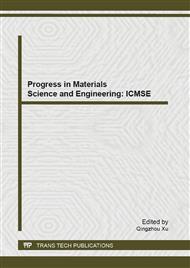[1]
M.W. Barsoum, The MN+1AXN Phases: a new class of solids thermodynamically stable nanolaminates, Prog Solid State Chem. Vol. 28 (2000), p.201.
DOI: 10.1016/s0079-6786(00)00006-6
Google Scholar
[2]
M.W. Barsoum, and T. El-Raghy, Synthesis and Characterization of a Remarkable Ceramic: Ti3SiC2, J Am Ceram Soc. Vol. 79 (1996), p. (1953).
DOI: 10.1111/j.1151-2916.1996.tb08018.x
Google Scholar
[3]
Y. Zhang, G.P. Ding, Y.C. Zhou, and B.C. Cai, Ti3SiC2—a self-lubricating ceramic Mater. Lett. Vol. 55 (2002), p.285.
Google Scholar
[4]
D. B. Lee, and S. W. Park, Oxidation of Ti3SiC2 between 900 and 1200oC in Air, Oxid. Met. 67 (2007), p.51.
DOI: 10.1007/s11085-006-9043-9
Google Scholar
[5]
M. W. Barsoum, T. El-Raghy, and L. U. J. T. J. Ogbuji, Oxidation of Ti3SiC2 in Air, J. Electrochem. Soc. Vol. 144 (1997), p.2508.
DOI: 10.1149/1.1837846
Google Scholar
[6]
W. Jeitschko, and H. Nowotny, Die Kristallstructur von Ti3SiC2– Ein NeuerKomplxcarbid-Typ, Monatasch. Chem. Vol. 98 (1967), p.329.
DOI: 10.1007/bf00899949
Google Scholar
[7]
X.L. Shi, M. Wang, W.Z. Zhai, Z.S. Xu, Q.X. Zhang, and Y. Chen, Influence of Ti3SiC2 content on tribological properties of NiAl matrix self-lubricating composites, Mater. Design. Vol. 45 (2013), p.179.
DOI: 10.1016/j.matdes.2012.08.060
Google Scholar
[8]
X.M. Fan, X.W. Yin, S.S. He, L.T. Zhang, and L.F. Cheng, Friction and wear behaviors of C/C-SiC composites containing Ti3SiC2, Wear. Vol. 274-275 (2012)188-195.
DOI: 10.1016/j.wear.2011.08.029
Google Scholar
[9]
American society for testing and materials. Standard test methods for densityof compacted or sintered powder metallurgy (PM) products using Archimedes'principle, ASTM B962-08, (2008).
DOI: 10.1520/b0962-17
Google Scholar
[10]
American society for testing and materials. Standard test method for Vicker's hardness of metallic materials, ASTM E92-82, e2, (2003).
Google Scholar
[11]
H. Li, L.M. Peng, M. Gong, L.H. He, J.H. Zhao, and Y.F. Zhang, Processing and microstructure of Ti3SiC2/ M (M = Ni or Co) composites Mater. Lett, Vol. 59 (2005), p.2647.
DOI: 10.1016/j.matlet.2005.04.010
Google Scholar
[12]
D. Sarkar, B.V.M. Kumar, and B. Basu, Understanding the fretting wear of Ti3SiC2, J. Eur. Ceram. Soc. Vol. 26 (2006), p.2441.
Google Scholar
[13]
S. Gupta, and M.W. Barsoum, On the tribology of the MAX phases and their composites during dry sliding: A review, Wear. Vol. 271 (2011), p.1878.
DOI: 10.1016/j.wear.2011.01.043
Google Scholar


